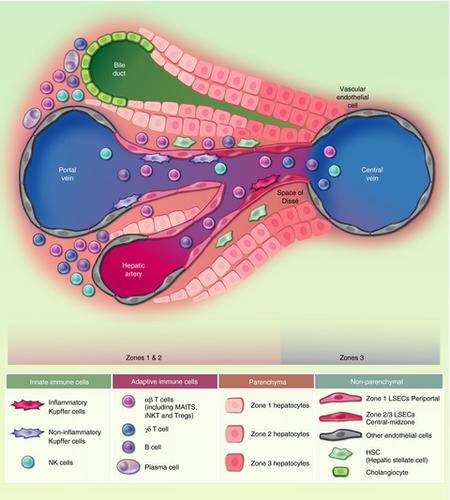当前位置:
X-MOL 学术
›
Immunology
›
论文详情
Our official English website, www.x-mol.net, welcomes your feedback! (Note: you will need to create a separate account there.)
The liver as an immunological barrier redefined by single-cell analysis.
Immunology ( IF 6.4 ) Pub Date : 2020-04-15 , DOI: 10.1111/imm.13193 Zania Stamataki 1, 2 , Leo Swadling 3
Immunology ( IF 6.4 ) Pub Date : 2020-04-15 , DOI: 10.1111/imm.13193 Zania Stamataki 1, 2 , Leo Swadling 3
Affiliation

|
The liver is a front-line immune tissue that plays a major role in the detection, capture and clearance of pathogens and foreign antigens entering the bloodstream, especially from the gut. Our largest internal organ maintains this immune barrier in the face of constant exposure to external but harmless antigens through a highly specialized network of liver-adapted immune cells. Mapping the immune resident compartment in the liver has been challenging because it requires multimodal single-cell deep phenotyping approaches of often rare cell populations in difficult to access samples. We can now measure the RNA transcripts present in a single cell (scRNA-seq), which is revolutionizing the way we characterize cell types. scRNA-seq has been applied to the diverse array of immune cells present in murine and human livers in health and disease. Here, we summarize how emerging single-cell technologies have advanced or redefined our understanding of the immunological barrier provided by the liver.
中文翻译:

单细胞分析重新定义了肝脏作为免疫屏障。
肝脏是前线免疫组织,在检测、捕获和清除进入血液(尤其是肠道)的病原体和外来抗原方面发挥着重要作用。我们最大的内部器官通过高度专业化的肝脏适应免疫细胞网络,在不断暴露于外部但无害的抗原时维持这种免疫屏障。绘制肝脏中的免疫驻留区室一直具有挑战性,因为它需要对难以获取的样本中的稀有细胞群进行多模式单细胞深度表型分析。我们现在可以测量单个细胞中存在的 RNA 转录本 (scRNA-seq),这彻底改变了我们表征细胞类型的方式。scRNA-seq 已应用于健康和疾病中小鼠和人类肝脏中存在的多种免疫细胞。在这里,我们总结了新兴的单细胞技术如何推进或重新定义了我们对肝脏提供的免疫屏障的理解。
更新日期:2020-04-15
中文翻译:

单细胞分析重新定义了肝脏作为免疫屏障。
肝脏是前线免疫组织,在检测、捕获和清除进入血液(尤其是肠道)的病原体和外来抗原方面发挥着重要作用。我们最大的内部器官通过高度专业化的肝脏适应免疫细胞网络,在不断暴露于外部但无害的抗原时维持这种免疫屏障。绘制肝脏中的免疫驻留区室一直具有挑战性,因为它需要对难以获取的样本中的稀有细胞群进行多模式单细胞深度表型分析。我们现在可以测量单个细胞中存在的 RNA 转录本 (scRNA-seq),这彻底改变了我们表征细胞类型的方式。scRNA-seq 已应用于健康和疾病中小鼠和人类肝脏中存在的多种免疫细胞。在这里,我们总结了新兴的单细胞技术如何推进或重新定义了我们对肝脏提供的免疫屏障的理解。



























 京公网安备 11010802027423号
京公网安备 11010802027423号